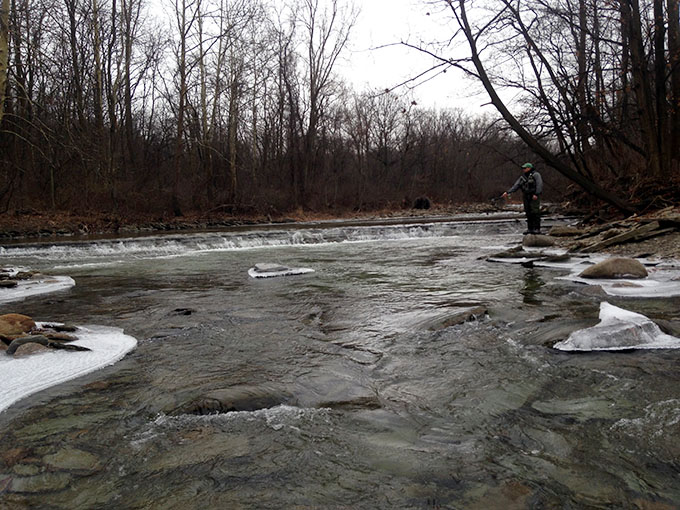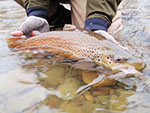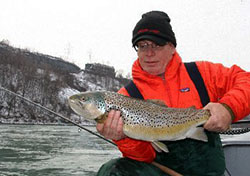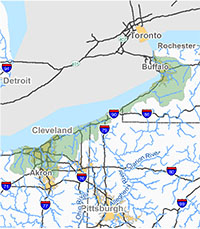As natural gas extraction expands across the Central Appalachian region, that industrial-scale energy development is encroaching on public lands that are critically important for fishing and hunting. In this report, Trout Unlimited takes a deeper look into those public places, outlining the potential risks posed by gas drilling operations and providing recommendations from sportsmen and women that promote responsible energy development.
Lake Erie Watershed

The Place
Home to one of the world’s largest freshwater commercial fisheries, Lake Erie hosts abundant fish populations, including steelhead, walleye, trout, smelt and bass. The Ohio portion of the Lake Erie watershed contains some of the largest and most historically significant wetlands in the lower 48 — critical areas for migrating and wintering waterfowl and other wildlife.An estimated 450,000 people fish in the Ohio waters of Lake Erie every year and contribute $680 million to Ohio’s economy.[i] Each fall, thousands of steelhead anglers from across the East descend on Lake Erie tributaries, primarily Pennsylvania’s Elk and Walnut creeks, Cattaraugus Creek in New York, and Ohio’s Conneaut Creek and Vermilion, Rocky, Chagrin and Grand rivers. The Lake Erie steelhead fishery is economically vital for fishing guides and charters, as well as local restaurants, hotels and businesses. According to a study conducted by the Pennsylvania Fish and Boat Commission, steelhead anglers spent nearly $9.5 million on trip-related expenditures in Erie County, Pa. in 2003, supporting more than 200 local jobs.[ii]
The Threat
Most of the Lake Erie watershed that overlies unconventional shale gas formations is located in Ohio. While shale gas drilling is just getting under way in Ohio, the state is experiencing the ancillary impacts related to Marcellus shale gas drilling and Ohio is quickly becoming a hot spot for Utica shale gas drilling. A portion of wastewater generated from drilling activities in Pennsylvania is carried by tanker trucks across state lines into Ohio and disposed of in deep underground injection wells. During transportation and disposal of the wastewater from Pennsylvania to Ohio, there is the risk of spills, accidents and leaks into Lake Erie tributaries and wetlands.While the transfer of water out of the Lake Erie basin is currently not permitted under the Great Lakes-St. Lawrence River Basin Water Resources Compact, water withdrawals for shale development are currently allowed if the water will be used in basin. In June 2012, Ohio’s governor signed a law that allows companies to withdraw an average of 2.5 million gallons of water per day from Lake Erie, over three months, without a permit. The law does not require a permit for withdrawals of 1 million gallons of water per day from the rivers and streams that feed Lake Erie.
Significant water withdrawals could have an adverse impact on stream flows and fishing in steelhead tributaries and potentially introduce invasive species. It is estimated that the Great Lakes have already lost $123 million from lost sport fishing opportunities as a result of invasive species in the lake.[iii] In the years to come, as Utica Shale is targeted for drilling across the region, Ohio is likely to see a significant increase in drilling and experience direct surface impacts in the Lake Erie watershed that may affect revenue generated by sport fishing in the basin.
The Need to Protect
 Sportsmen and women are becoming increasingly concerned about the potential impacts from drilling on fish, wildlife, sporting activities and the recreational economy. Anglers and hunters want to work with the industry and the state to: (1) develop rules that limit the volume, timing and location of water withdrawals within the basin to protect the streams, wetlands and bodies of water in the Lake Erie watershed; (2) create a comprehensive invasive species control program for gas drilling activities that includes training for industry workers and routine monitoring, inspection and reporting methods; and (3) conduct a study of the cumulative impacts of disposing of shale gas wastewater in underground injection wells in Ohio.
Sportsmen and women are becoming increasingly concerned about the potential impacts from drilling on fish, wildlife, sporting activities and the recreational economy. Anglers and hunters want to work with the industry and the state to: (1) develop rules that limit the volume, timing and location of water withdrawals within the basin to protect the streams, wetlands and bodies of water in the Lake Erie watershed; (2) create a comprehensive invasive species control program for gas drilling activities that includes training for industry workers and routine monitoring, inspection and reporting methods; and (3) conduct a study of the cumulative impacts of disposing of shale gas wastewater in underground injection wells in Ohio.
SPORTSMEN IN THE SPOTLIGHT
We need to proceed cautiously. It doesn’t have to be a race to pull everything out as fast as we can get it out.”Jerry Darkes, Fly fishing guide



